12 Ways of Looking at a Garden
Permaculture in an Age of Change
Jamie Runnells
“Here are 12 permaculture principles to begin with, gathered from permaculturists of the land, of the house, and of the mind.”
When the stay-at-home order for the crisis-that-shall-not-be-named rolled across our little island, I had a sudden urge to plant some food. This was highly unusual for me, as until now I have only been mildly garden-curious. But when I got to the garden store, I was greeted with empty shelves where there once had been packets and packets of vegetable seeds. I carried the last packet of peas and an unusual cucumber variety to the cash register.
“Ah, the veggies,” said the woman behind the counter. She wore a medical mask, but her eyes were smiling. “Everyone wants to be able to feed themselves.”
It feels like not that much of a stretch to say that everyone wants to garden this year, partly out of a desire to be resilient and self-sufficient, partly to make something beautiful and nourishing.
But it wasn’t just gardening. The neighborhood community group organized a cleanup for Earth Day, and with clearer schedules, we joined in for the first time. I told an acquaintance about my strange leanings over Zoom, and he said, with a twinkle in his eye, “Sounds like you’re becoming a permaculturist.” Perma-what? It turns out there’s a way of thinking that fits beautifully with the moment we’re in. And if you think that practicing permaculture means buying 20 acres of land, a windmill, and a flock of goats, like I did, you might want to have a second look.
Permaculture got its start in the 1970s when two Australians, Bill Mollison and David Holmgren, got curious about why farming required so much labor and so many inputs, whereas a forest system was entirely, efficiently self-sustaining, relying on sun, rain, and soil whose nutrients were replenished every year by falling leaves and animal byproducts that self-composted into rich soil.
They came up with a design philosophy that is the opposite of “move fast and break things.” Permaculture is akin to aikido—working with the inherent properties of the elements in any system to foster self-sustaining relationships that still achieved the aims of the designers. There was far less brute force involved, and far more skill, knowledge, and attention.
Still rooted in food security (the word “permaculture” is a portmanteau of “permanent” + “agriculture”) permaculture is, at its heart, a design methodology, and its applications have proliferated like a zucchini bed in late summer. You can permaculture not just homesteads and gardens, but cities and friendships, neighborhoods and your five-year plan, your house, your apartment, your family, your business, even your inner life.
Starhawk (the name is a mononym) is a renowned permaculture teacher who has lectured at Harvard. She says permaculture is “the art of designing beneficial relationships,” and that can happen anywhere, with anything: “It’s a design system that’s about applying our minds, our intelligence, and our ethics.”
Here, then, are 12 permaculture principles to begin with, gathered from permaculturists of the land, of the house, and of the mind. One thing to remember: “Everything gardens”—that is, all living things tend and interact with their environment in order to achieve what they want—so everything you do is gardening, too.
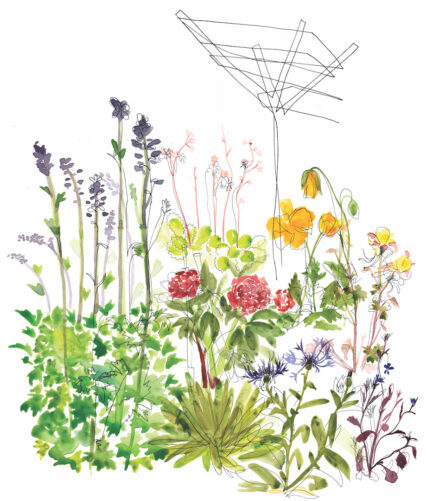
1. START WHERE YOU ARE. Unlike other design approaches, permaculture doesn’t assume you’re starting with a blank slate—it assumes that something is already happening, and energy is already moving, in this space. There are already patterns of rainfall and water movement, there’s already a neighborhood in place, and you, the designer, are already a person with preferences, habits, and a history. Begin there. “[Permaculture’s founder] Bill Mollison said, start at your doorstep,” says Celia Macaulay, a house-and-garden designer who uses permaculture. “Start where you are, and get that good.”
2. BEFORE YOU ACT, OBSERVE. There’s no one-size-fits-all in permaculture. Solutions are always unique, and they grow out of the conditions already in place. You’ll need to understand them to know what to do next, says permaculture-inspired life design teacher Heather Hopkins: “A lot of permaculture people say, if you are going to buy a piece of land, you do nothing for a year except observe and interact.” Taking a year is fine for a farm, but even taking twenty minutes to observe a situation and its context before plunging in can yield results. Observation can help you ask the right questions. And existing conditions, plus your goals, will tell you what to do next.
3. START SLOW AND SMALL. Permaculture might be called “slow design,” although results can come quickly after decisions are made. Rather than coming up with a whole new system, make just one or two adjustments and see how they percolate through. It’s an approach that assumes there will be plenty of mistakes, says Starhawk: “We make mistakes in permaculture, but we do it carefully. We start slow and small.” Smaller mistakes mean that each mistake has a lower cost, which can make risk-taking easier.
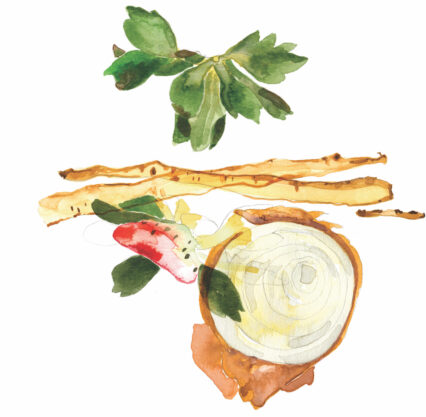
4. OBTAIN A YIELD. Starhawk renders this technical-sounding term as “Get some.” There’s an idea circulating that in order for the rest of the planet to do well, humans need to give up most of what they love. Not so, says Starhawk: “Permaculture is altruistic, but it’s not totally selfless. The idea is that there is abundance in the universe, and we need to get some if we’re going to sustain our work.”
A yield isn’t only measured in terms of calories or dollars, either—it’s any result that creates benefit. Tomatoes and cucumbers are a yield. Beauty is one of the most necessary yields, says Australian designer Cecilia Macaulay. Happiness, fitness, friendship, calm, knowledge, and laughter are yields, too. If you want to build a butterfly garden and the butterflies arrive, that’s a yield.
5. WASTE NOTHING, AND FEED WHAT FEEDS YOU. One of permaculture’s foundational principals is that one being’s waste is another being’s resource—that, as Macaulay says, “nothing is bad; it’s just in the wrong place.” The activity most associated with permaculture is composting, the turning of biological scraps into enrichment for the earth, so it can create more food without resorting to artificial or chemical inputs. It sounds pedestrian but Macaulay describes it as a spiritual practice: “It’s a prayer to the universe, a thanks to Mother Nature: you fed me, Mother Nature; I’m going to feed you. It’s a physical reminder that we live in a universe that is on the side of life.”
That principle can also apply to people. That friend who calls you too often, offering time and attention that you can’t afford to accept? Connect her with a charity that needs volunteers, or someone else who needs company.
6. VALUE THE EDGES AND THE MARGINS. “Where two ecosystems meet, things are more abundant, more diverse, and they flourish,” says Hopkins. “Where a meadow meets a forest, where the ocean meets the land, you have an edge,” a transition zone in which you can find a richness and diversity of species that draw on the resources of both worlds. In a garden, that might translate to the deliberate creation of wandering or curved, rather than straight, lines, providing more edges where plants can flourish: “Things will grow better along the edges than they will in the middle,” says Hopkins. That applies to people too, she says, both where two people meet and in finding internal edges, where true challenge meets balance. Says Hopkins, “Permaculture would say, when you find any edge, you’re going to flourish. In life design, we talk about expanding your comfort zone so that the world becomes more accessible to you, and you can explore things you haven’t explored in the past.”
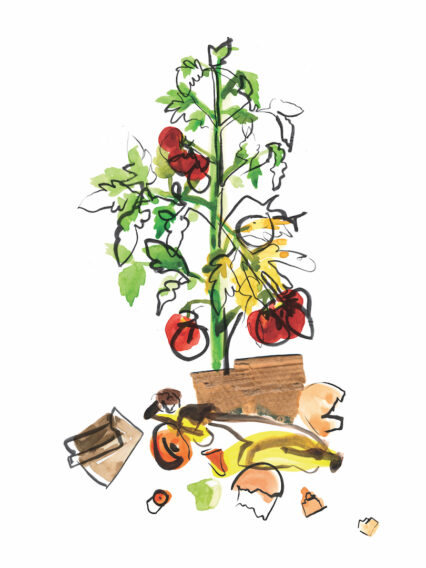
7. VALUE AND USE DIVERSITY. In ecological terms, a diverse system is a robust system, with every element supporting every other element. Farmer and teacher Michael Nickels says, “If you’ve got a monoculture of something, it’s very prone to disease. The more complex a system, the healthier the system.” In a garden, it would mean an array of plantings that can complement each other and serve many different functions. On a neighborhood board or even in a boardroom, it might mean making sure that a variety of ages, genders, cultures, and personalities have a seat at the table.
8. VALUE AND SUSTAIN WHAT’S LOCAL TO YOU. A shared place creates instant affinity, and that’s a resource in itself. Local actions have local benefits and yields. Take the example of buying produce from a local CSA or a neighborhood cooperative. You might walk or bike there rather than driving miles to the store, improving your health, saving time, and removing pollution from the air; the food is fresher, lasts longer in the fridge, and you know where it came from; you have supported your local community member and created a personal bond, and because you’ve supported both food growing and mutual trust, “when there is a crisis, our neighbor has the food, and we’re not panicking.” This is not just a rural dream; Nickels says it’s just as possible in downtown Toronto or Los Angeles, where there might be less arable land but there’s more human creativity and resourcefulness.
9. DESIGN IN ZONES. Imagine concentric circles with you as the center. The innermost circle is Zone 1, and Zones 2, 3, 4, and so on radiate outward from there. Then design accordingly. “The things that we use most often are closest in; the things you use less often farther out,” says Starhawk. “In permaculture, we think of it as designing a homestead, but we can scale up and scale down. On the smallest scale, it can be something like my kitchen. Instead of keeping the cheese grater in a drawer on the other side of my kitchen, maybe I should hang it on a hook by the stove.”
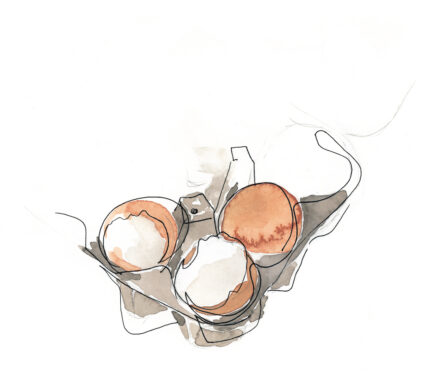
10. MAKE SURE ONE EFFORT HAS MANY BENEFITS. Otherwise known as killing two birds with one stone. “How do we take the resources we have and get more uses and benefits out of them?” says Starhawk. Planting a wild rose hedge to block trespassers, enhance privacy, and provide beauty and joy in the summer and rosehip tea in the fall is another. The hedgerows of England are a perfect example; often hundreds of years old, they were planted to mark and enforce field boundaries, but also provide sheltered, linked travelways for wildlife and game, and yield summer fruit like crabapples, damson plums, cherries, and sloe.
11. MAKE THE SMALLEST CHANGE POSSIBLE FOR THE BIGGEST EFFECT. If you don’t have to change a lot, don’t do it—that’s a waste of energy. Even the tiniest actions can yield outsize results if they’re the right actions. If you’re living alone in a dark city apartment, says Macaulay, you can buy a plant you can love. And if there’s not enough light for the plant, find a neighbor with more sun, give the plant to them—and ask them: “When it has a flower, can you give me one?” Suddenly, you have not just a plant, but reciprocity and a relationship.
12. CREATIVELY USE AND RESPOND TO CHANGE. Permaculture has resiliency built into it with its focus on creating self-sustaining systems; staying alert to changing conditions; relying on local networks; and viewing trust, support, and relationships as resources. When change comes, either personally or societywide, you’ll be ready for them and can meet them together. “If you’re applying these principles and living according to them, then you’ll change in accordance with what’s happening without it devastating you,” says Hopkins. Emergency and disaster preparedness consultant Chris Gilmour calls permaculture “a really powerful skill set for the time and era we’re in.”
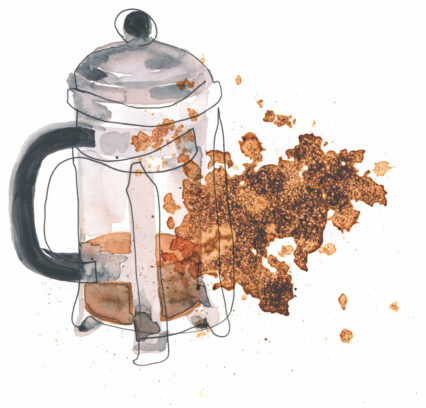
•••
“Permaculture isn’t really anything new,” says Hopkins. “It’s almost like we’re just remembering the things that were important to us: connection to ourselves, connection to each other, and connection to the land. One of the reasons people are baking bread, growing gardens, doing all these things is that they’re remembering what it feels like to connect.”
And for Hopkins, that has been the gift of this involuntary pause: “Someone said to me that this whole time period has illuminated the fault lines in society—but is also providing us with the opportunity to fix them.” We don’t have to move fast and break things to do it. Change can be achieved one small, slow step at a time.
The Herb Spiral
For rural and suburban gardeners, traditional permaculture’s signature move is the herb spiral, a stone-sided garden bed planted with herbs that’s raised in the center and spirals down to the ground. This shape creates microconditions: Some parts of the spiral will get more sun or shade; others will naturally receive more moisture or better drainage. That means that you can keep many culinary herbs with different light, soil, and water requirements all thriving close to your kitchen door. Not only that, it’s beautiful to look at—and spirals are an ancient symbol of spiritual development and evolution. Who wouldn’t want to be reminded of that every time they walked out their back door?
Your Kitchen
Cecilia Macaulay’s specialty is permaculture for living spaces, and she recommends starting there. Gardening is hard, says Macaulay, and although not everyone needs to grow food, “everyone has to eat.” So much time is spent in a kitchen, preparing food, eating it, and cleaning up, that a well-designed kitchen can encourage the behaviors you want to see show up in your life.
Removing clutter, putting things where you use them, and adding beauty and invitations to slow down are all part of her work. She describes clients who needed more connection with people, for whom adding a kitchen table created a space and opportunity for company to linger and share meals. “That’s permaculture,” she says. “You find the minimum intervention with the maximum effect, and you do it.” Some clients ‘get it,’ and the effect can be transformative, says Macaulay: Some people, after being with me for an hour, would get their kitchen right—then bit by bit, they would get the pattern for their whole life.”
The City Repair Project
Based in Portland, the City Repair Project takes a permaculture approach to “placemaking,” or building community and connection among people and between people and their environment. It is best known for its vibrant community-designed and-organized intersection paintings that help people get to know their neighbors with a project that yields beauty and fun and a stronger sense of the uniqueness of each neighborhood. Repainting the designs every few years provides another opportunity for neighbors to come together.
Your Future
Life design teacher Heather Hopkins fell in love with permaculture when she first took an intensive course many years ago—but she didn’t fall in love with agriculture. “As the course progressed, I realized I don’t really want to be a farmer. But as we were learning all the principles and the ethics, I was constantly seeing how you can apply all that to your life in ways that have nothing to do with farming or gardening.” Eventually, Hopkins was hired at the school she had once attended to teach a life-design course that used the principles of permaculture, from starting where you are to observing carefully to taking small and slow steps.
Hopkins says that in her practice, many clients come to her with lives that aren’t what they imagined, but they can’t think what to do except erase everything and start again. “A lot of people, when they’re struggling, want to ditch everything and create a whole new life—but what generally works better is observing and asking questions: “How can I tweak this? What can I change here?” In life design, a lot of people find that to achieve what they want to achieve, they can do the small things, and it actually gets them where they want to go.”


